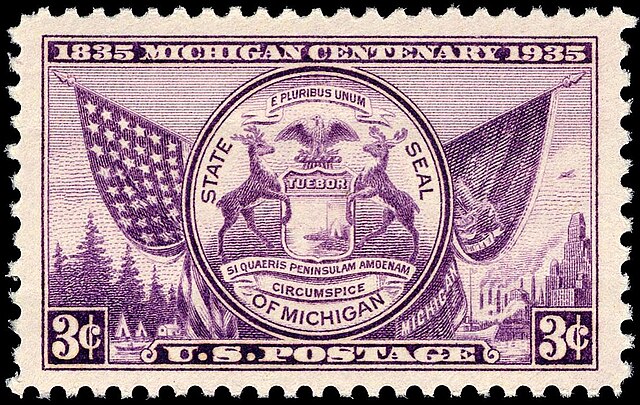The Keweenaw Peninsula is the northernmost part of Michigan's Upper Peninsula. It projects into Lake Superior and was the site of the first copper boom in the United States, leading to its moniker of "Copper Country." Its major industries are now logging and tourism, as well as jobs related to Michigan Technological University.
Cross-section of the Lake Superior basin showing the tilted strata of volcanic rock that form both the Keweenaw Peninsula and Isle Royale
Keweenaw Snow-mometer north of Mohawk on US 41
Some shelf ice remains along the shore of the peninsula as most of the ice breaks away; taken at 11:12:06 AM Central Standard Time on February 20, 2021 from the International Space Station
Snow on the peninsula; taken at 2:05:48 PM CST on April 3, 2021 from the ISS
Michigan is a state in the Great Lakes region of the Upper Midwest region of the United States. It borders Wisconsin to the northwest in the Upper Peninsula, and Indiana and Ohio to the south in the Lower Peninsula; it is also connected by Lakes Superior, Michigan, Huron, and Erie to Minnesota and Illinois, and the Canadian province of Ontario. With a population of nearly 10.12 million and an area of 96,716 sq mi (250,490 km2), Michigan is the 10th-largest state by population, the 11th-largest by area, and the largest by area east of the Mississippi River. Its capital is Lansing, and its largest city is Detroit. Metro Detroit is among the nation's most populous and largest metropolitan economies. The name derives from a gallicized variant of the original Ojibwe word ᒥᓯᑲᒥ, meaning "large water" or "large lake".
Père Marquette and the Indians (1869), by Wilhelm Lamprecht
Treaty of Paris, by Benjamin West (1783), an unfinished painting of the American diplomatic negotiators of the Treaty of Paris which brought official conclusion to the Revolutionary War and gave possession of Michigan and other territory to the new United States
Commemorative stamp, issue of 1935, celebrating the 100th anniversary of Michigan statehood.
Detroit in the mid-twentieth century. At the time, the city was the fourth-largest U.S. metropolis by population, and held about one-third of the state's population.








